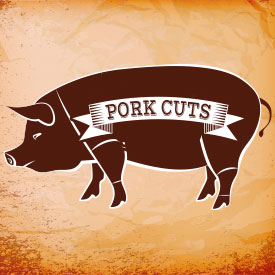
Pork earned the nickname as the “other white meat” because producers learned to create pork products that are as low in fat as some cuts of chicken. Lean cuts of pork are a good source of protein and essential nutrients. Just as you would do with beef, the key is to go lean and pay attention to portion sizes. According to the USDA MyPlate guidelines for daily protein intake, most adults should eat about 5-6 ½ ounces of protein each day. The serving size of protein for an adult should average about 3.5 ounces, which is about the size of a deck of cards.
The bottom line is to keep it lean, and eat small portions. Select fruit sauces as toppings and vegetable dishes for sides.
At the Market:
Cuts from the loin of the pig will be the leanest. Selecting the right cut depends on what you plan to prepare. Roasts are great for big groups and a slow cooker, but if you are feeding a family of 3-4 people, the tenderloin or chops might be a better option.
Leaner cuts of pork include:
- Tenderloins
- Country Ribs and Back Ribs
- Butterfly Chops
- Center Rib Roasts
- Boneless Sirloin Roasts
Storage:
Raw ground pork can be stored in the refrigerator for 1-2 days. Raw roasts, chops and tenderloins can be stored in the refrigerator for up to 4 days.
Ground pork properly packaged in an airtight container can be safely stored in the freezer for up to 3 months. Raw roasts, chops and tenderloins can be safely stored up to six months if properly packaged.
Whole smoked ham and whole ham slices can be stored in the refrigerator for 3-4 days. Smoked sausages, hot dogs, bacon and other luncheon meats can be kept for up to 7 days. Freezing is not recommended for whole cooked ham. Cut up pieces can be frozen for use in soups and stews.
Bacon can be kept sealed for up to the recommended date on package. Once the package is opened it should be used within 7 days. Freeze sealed packaged bacon for up to one month.
*Source: National Pork Council
Preparation:
Defrost pork in the refrigerator in its wrapping or in the microwave. If you choose to defrost using the microwave, cook pork immediately after thawing. The recommended cooking temperature for pork is 145 degrees. Because of updated feeding practices, Trichinosis (a food borne illness) is not the threat is used to be with undercooked pork.
Always trim visible fat before cooking. Pork can be grilled, braised, broiled, roasted, stewed, or sautéed. Pork can be used in a variety of ethnic dishes including Mexican, Polish, Puerto Rican, Chinese and many others. Good choices for pork seasonings include sage, thyme, pepper, and jerk spices. Ground pork is great for stuffed peppers and cabbage rolls.
Recipe Ideas:


